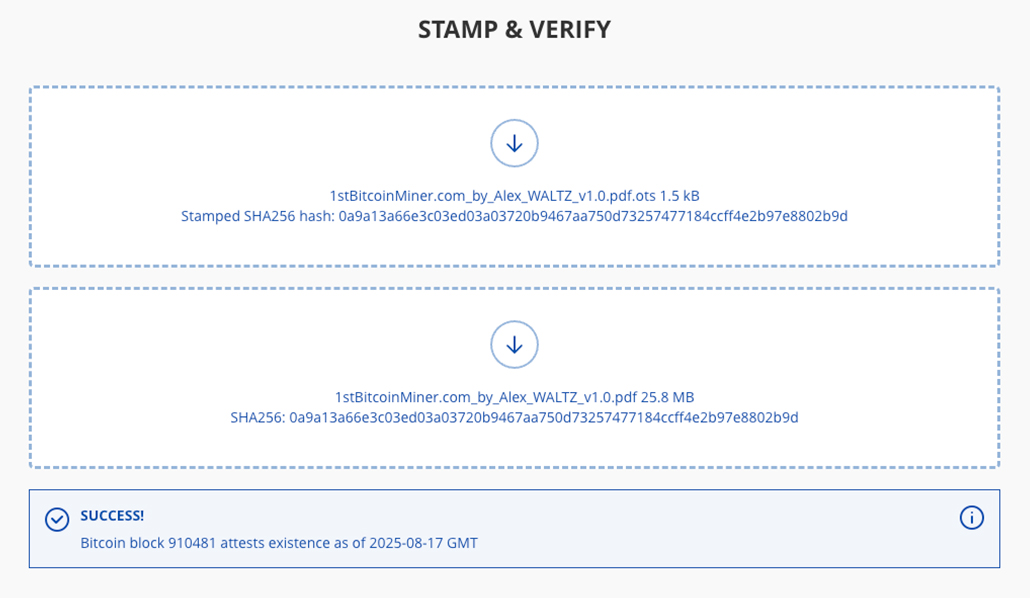👋 Hello I’m Alex Waltz and I really love Bitcoin.

📽️ I make Movies & Commercials.
And now I officially am a Bitcoin Historical Researcher — but even before writing this piece, I was very interested in Bitcoin archaeology. Quite often I tweet about historical Bitcoin things. Here are a few recent examples.
I have been in the Bitcoin space for quite some time and have been involved in various projects over the years. In the early years, more mining stuff; built a few apps (that never took off); and most recently, I had a boutique OTC desk in London, which I closed down to become a movie director.
I very strongly believe that good things only come out of obsession.
Currently, I have 2 movies in the pipeline — one of them is finished and waiting for release. Follow me on X for updates!
And if you want your company to be advertiser in my movie contact me.

Licensing & Rights
✅ What This License Allows:
You are free to share, distribute, copy, remix, or otherwise use this article for any purpose — personal, educational, or commercial — as long as you provide attribution.
(e.g. “Research by Alex Waltz, originally published at 1stBitcoinMiner.com”)
🎬 Reserved Rights: Dramatization & Adaptation
As a filmmaker, I may choose to develop a project based on this research myself, and thus reserve the Dramatization & Adaptation rights.
While the content is openly licensed for most purposes, I have explicitly reserved the rights to dramatized adaptations, including but not limited to:
- Film (feature-length, short, or any motion picture format)
- Television (series, episodes, or specials)
- Theater (stage plays, musicals, or live performances)
- Docu-series, documentaries, or other visual/audiovisual storytelling formats (e.g. animated retellings, or VR experiences)
⚠️ This means you may not create, produce, or distribute any dramatized, scripted, or adapted versions of this content — whether for profit or not — without my express written permission.
Please note:
- The historical facts uncovered here are public domain and may be freely referenced.
- The narrative structure, analysis, and expression are protected by copyright.
If you’re interested in collaborating on, licensing, or producing a dramatized version, adaptation, or any related media project, please contact me directly.
📩 Contact: alexwaltz212@gmail.com
© 2025 Alex Waltz. All rights reserved except as explicitly granted above. For any other uses not covered here, or if you have questions about permissions, feel free to reach out. These permissions are granted on a non-exclusive, worldwide, perpetual basis and are irrevocable, as long as you comply with the terms.
Effective as of August 18, 2025. Subject to change; check back for updates.
Disclaimer
It might seem unusual to include a disclaimer on a site like this, but given past instances where Bitcoin-related historical research has been misinterpreted or weaponized through legal channels, I feel it’s necessary to be clear about the intent and limits of this work.
Nature of Content
The content presented on this website constitutes historical research and analytical commentary concerning the early development of Bitcoin. All materials are provided on an “as is” basis and reflect the author’s personal interpretations and informed speculation derived from publicly accessible sources, including but not limited to email archives, forum posts, debug logs, and blockchain data.
Accuracy and Limitations
The author makes no representations or warranties, express or implied, regarding the accuracy, completeness, reliability, or timeliness of the information contained herein. While reasonable efforts have been made to base conclusions on factual evidence, certain assumptions and inferences are necessarily speculative in nature. This site does not purport to provide a definitive or authoritative account of historical events.
No Legal or Financial Advice
Nothing on this website shall be construed as legal, financial, investment, or technical advice. The author is not a licensed financial advisor, attorney, or technical consultant.
On Individuals Mentioned
All references to individuals are based solely on their publicly verifiable involvement in early Bitcoin history. No statements are intended to speculate on private motives or cast judgment on character. The analysis presented reflects interpretations of public data and communications, and any mention of a person is included for historical context only.
Limitation of Liability
By accessing or using this website, you expressly acknowledge and agree that the author shall not be held liable for any direct, indirect, incidental, consequential, or other damages arising out of.
🖖 Thanks!
I would like to thank the following people, who have contributed indirectly or directly to this research:
Aaron van Wirdum for pointing out a small error in the early stages of the research, which prompted me to dig deeper and ultimately led to the discovery of the network halts.
Bitstein for showing me how to find the hashes of Bitcoin v0.1.1 and v0.1.3 in the RSS file on the Web Archive.
Sergio Demian Lerner for coming up with the genius idea of analyzing the extraNonce in the scriptSig of coinbase transactions, which I used in this research.
Emzy for offering some feedback before released.
Sjors Provoost for offering some feedback before released.
Please note: None of the people mentioned have formally reviewed or endorsed this work. Any mistakes, inaccuracies, or misinterpretations are entirely my own.
📎 OpenTimestamps Verification
1. The Files
The PDF version of the research article has been timestamped using OpenTimestamps.org to cryptographically prove its existence as of a specific moment in time.
Here are the associated files:
- 📄 PDF:
1stBitcoinMiner.com_v1.0_by_Alex_WALTZ.pdf - ⏱ OTS Timestamp File:
1stBitcoinMiner.com_v1.0_by_Alex_WALTZ.pdf.ots - 🔐 Hash (SHA-256):
0a9a13a66e3c03ed03a03720b9467aa750d73257477184ccff4e2b97e8802b9d
You can use these files to independently verify that the PDF existed at the time it was timestamped.
2. How to Use It
Using the website
You can simply drag and drop the files into OpenTimestamps.org.

Or use your own computer
If you don’t want to trust the OpenTimestamps website, use your own device.
You’ll need access to a Bitcoin node for the OTS client to extract the exact date. Without a node, ots verify only shows the block height and may warn about unverified attestations. For full trustless verification, connect to a node.
If you don’t allow node access, run ots info to get the block height, then check a block explorer to see when that block was mined.
Install the OTS client
If you have Python installed:pip3 install opentimestamps-clientDownload the
.pdfand.otsfiles
Place both in the same folder.Verify the timestamp
Run:ots verify 1stBitcoinMiner.com_by_Alex_WALTZ_v1.0.pdf.ots
This confirms the timestamp and shows the anchoring block.Remote node (optional, full verification without local setup):
ots verify --bitcoin-node http://rpcuser:rpcpassword@remote-host:8332 1stBitcoinMiner.com_by_Alex_WALTZ_v1.0.pdf.ots
This fetches block data remotely and prints a success message with the human-readable date.See the date
Run:ots info 1stBitcoinMiner.com_by_Alex_WALTZ_v1.0.pdf.ots
Note the block height and look it up in a block explorer (e.g., mempool.space).
Example: if it shows BitcoinBlockHeaderAttestation(910481), search for block 910,481 to see the mining date 17 August 2025 17:45:33 UTC
3. What Is OpenTimestamps?
OpenTimestamps is a free, open-source project that uses the Bitcoin blockchain to provide trustless, decentralized timestamps.
Think of it like a digital notary — but one that’s cryptographically verifiable and anchored to Bitcoin itself.
When you timestamp a file, OpenTimestamps doesn’t store the file. Instead, it creates a proof — a tiny .ots file — that can later be used to confirm your document existed before or at a certain time.
4. How It Works
Hashing
The file is hashed (turned into a unique digital fingerprint).Aggregation
That hash is bundled together with others and eventually included in a Bitcoin transaction.Blockchain Anchor
The timestamp proof links your document’s hash to a specific block in the Bitcoin blockchain.Verification
Anyone can later verify your document using the.otsfile, without needing access to the original timestamping server.
You don’t need to trust OpenTimestamps or any third party — just Bitcoin itself.
5. Why I Used OpenTimestamps
- The research includes original discoveries about Bitcoin’s earliest moments.
- OpenTimestamps provides proof of authorship and timing — without relying on any company, server, or copyright system.
- It allows anyone, now or decades from now, to prove that this document existed as it does today — no matter what happens to the site.
I wanted to make this investigation not just informative, but also to allow verification of its creation.